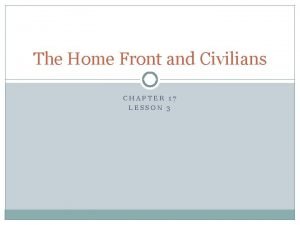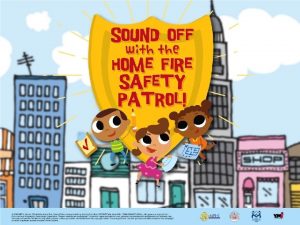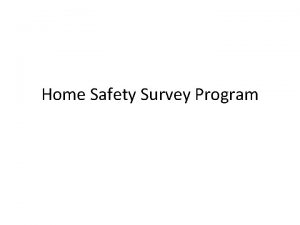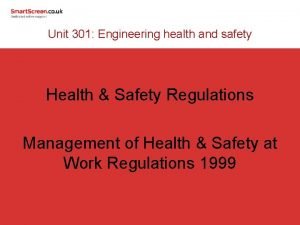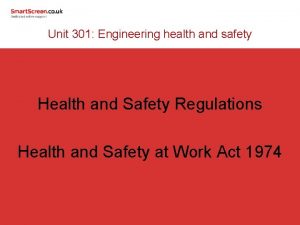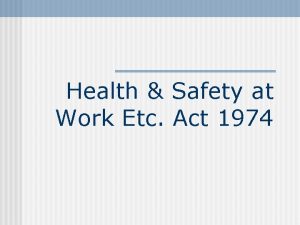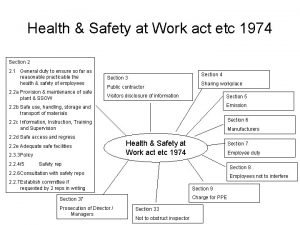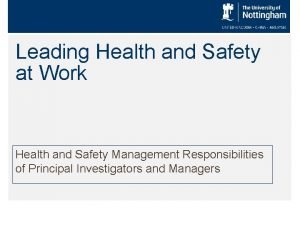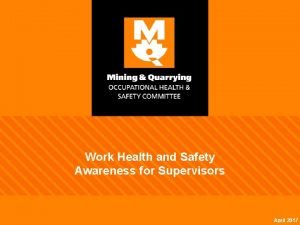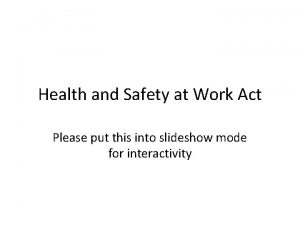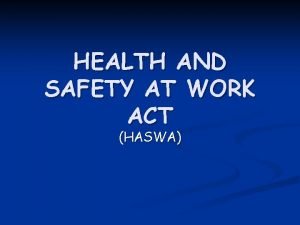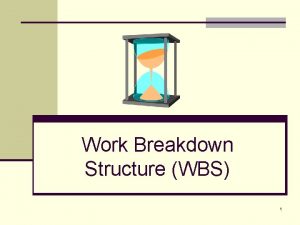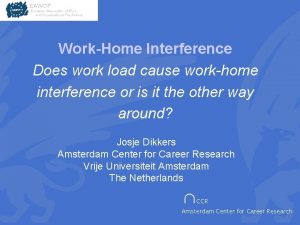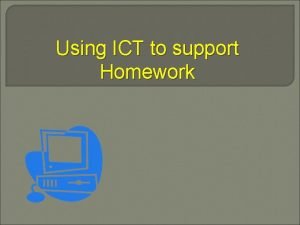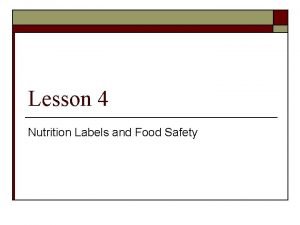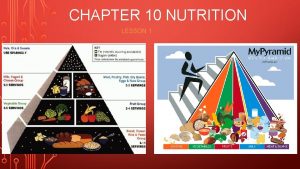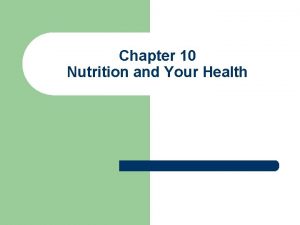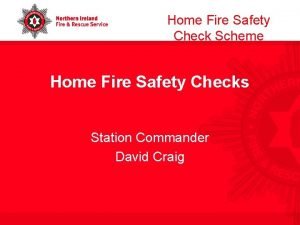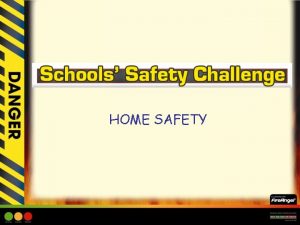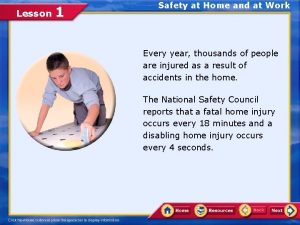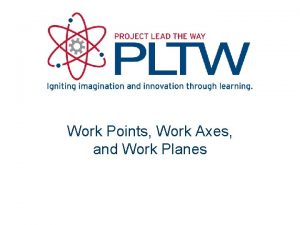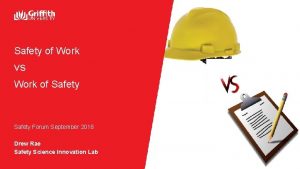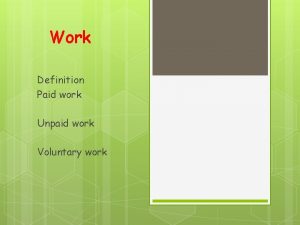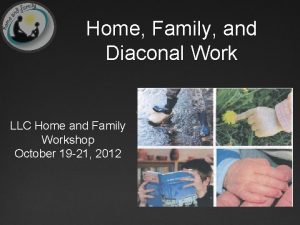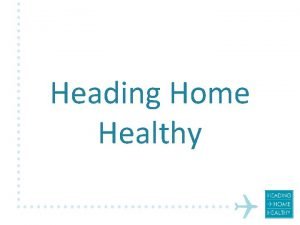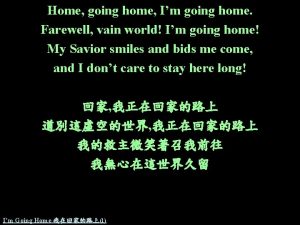Lesson 1 Safety at Home and at Work




































- Slides: 36

Lesson 1 Safety at Home and at Work Every year, thousands of people are injured as a result of accidents in the home. The National Safety Council reports that a fatal home injury occurs every 18 minutes and a disabling home injury occurs every 4 seconds.

Lesson 1 Lesson Objectives In this lesson, you will learn to: • Develop strategies for preventing accidental injuries at home and at work • Examine proper training and procedures to prevent accidental injuries

Lesson 1 Accidental Injuries Types of Injuries • There are two types of injuries—intentional and unintentional, or accidental. • An intentional injury is the result of a deliberate attempt to cause harm. • One goal of Healthy People 2010 is to reduce the number of deaths caused by unintentional or accidental injuries.

Lesson 1 Accidental Injuries Strategies for Preventing Accidental Injuries Although accidental injuries often seem to be random events, experts have observed an accident chain.

Lesson 1 Safety at Home Preventing Fires • Three elements—fuel, heat, and oxygen—must be present for a fire to occur. • Fuel can be carelessly stored rags, wood, gasoline, or paper. • A heat source can be a lighted match, a damaged electrical wire, a smoldering cigarette, or a pilot light. • The oxygen in the air feeds and fans the flames.

Lesson Safety at Home 1 Tips to Avoid Unintentional Fires Never leave a burning candle unattended. Store matches and lighters out of the reach of children. Make sure that a person doesn’t fall asleep while smoking. Keep stoves and ovens clean. Replace frayed electrical cords.

Lesson 1 Safety at Home Fire-Safety Equipment • One smoke alarm should be located on every floor of a home, preferably outside a sleeping area and near the kitchen. • The alarm should be tested once a month and batteries should be replaced at least once a year. • Check the dial on your fire extinguisher periodically to ensure that it still has enough pressure to work in an emergency. • When using an extinguisher, stand away from the flames; aim at the source of the fire, not at the flames; and move the spray from side to side.

Lesson 1 Safety at Home Preventing Falls • Keep stairways well lit, in good repair, free of clutter, and equipped with sturdy handrails and nonskid stair strips. • Keep the floor clean and use nonskid throw rugs, or place nonskid mats under rugs. • Make sure bathtubs and showers have safety rails. • Do not run electrical or telephone cords across areas where people walk. • If there are small children in the home, install adjustable safety latches so that windows will open only a few inches. • Use a sturdy step stool when reaching for items in high places.

Lesson 1 Safety at Home Preventing Electrical Shock • Unplug an electrical appliance immediately if anything seems to be wrong. Always pull on the plug, not the cord. • Inspect cords periodically for signs of cracked insulation, and replace frayed cords immediately. • Do not run cords under carpets or rugs. • Check outlets and extension cords to make sure they aren’t overloaded. • In homes with small children, cover unused outlets with plastic protectors.

Lesson 1 Safety at Home Preventing Poisoning • Keep medications and other potentially poisonous substances in childproof containers and out of the reach of children. • Dispose of any expired medications. • Store all household chemicals in their original containers. • Never mix household chemicals that could give off toxic gases when combined. • Make sure there is adequate ventilation when using fuel-burning appliances.

Lesson 1 Safety at Home Firearm Safety • Never point a firearm at anyone for any reason. • Treat all firearms as if they are loaded. If you find a firearm, leave the area and tell an adult. • Store firearms unloaded, and store the ammunition separately. • Both should be in locked cabinets that are well out of the reach of children.

Lesson 1 Common Strategies for Safety at Home

Lesson 1 Computer Workstation Design Safety at Home

Lesson 1 Safety on the Job Preventing Injuries to Teens on the Job The Department of Labor prohibits anyone under 18 from doing certain jobs, including: • Roofing and construction work. • Demolition. • Driving a forklift and any vehicle. • Operating power-driven machinery. • Handling explosives and radioactive materials. Both employees and employers must follow safety rules issued by the Occupational Safety and Health Administration (OSHA).

Lesson 1 Quick Review Choose the appropriate option. Q. An alarm that is triggered by the presence of smoke is called a(n) _____. 1. fire hydrant 2. accident chain 3. smoke alarm 4. fire extinguisher

Lesson 1 Quick Review - Answer A. 3. smoke alarm An alarm that is triggered by the presence of smoke is called a smoke alarm. Click Next to attempt another question.

Lesson 1 Quick Review Choose the appropriate option. Q. Which of the following is NOT a step in the accident chain? 1. Situation 2. Unsafe habit 3. Unsafe action 4. Re-evaluation

Lesson A. 1 Quick Review - Answer 4. re-evaluation Steps in the accident chain do NOT re-evaluation. Click Next to attempt another question.

Lesson 1 Quick Review Choose the appropriate option. Q. The three elements that must be present for a fire to start are fuel, heat source, oxygen, and structure. True False

Lesson 1 Quick Review - Answer A. False. The three elements that must be present for a fire to start are fuel, heat source, and oxygen. Click Next to attempt another question.

Lesson 1 Quick Review Choose the appropriate option. Q. For specific jobs that a teen might have, and to prevent accidental injuries on those jobs, developing a checklist that features accident safety strategies is optimal. True False

Lesson 1 Quick Review - Answer A. True. For specific jobs that a teen might have, and to prevent accidental injuries on those jobs, developing a checklist that features accident safety strategies is optimal. Click Next to attempt another question.

Lesson 1 End of Lesson 1 Click Home to view the Main menu.

Lesson 1 Accidental Injuries Types of Injuries • There are two types of injuries—intentional and unintentional, or accidental. • An intentional injury is the result of a deliberate attempt An unintentional to cause harm. injury is any injury resulting from an • One goal of Healthyunexpected People 2010 is to or reduce the number event, of deaths caused by unintentional or accidental injuries. accident.

Lesson Accidental Injuries 1 Strategies for Preventing Accidental Injuries Although accidental injuries often seem to be random events, experts have observed an accident chain. An accident chain is a sequence of events that leads to an unintentional injury.

Lesson 1 Safety at Home Fire-Safety Equipment • One smoke alarm should be located on every floor of a home, preferably outside a sleeping area and near the kitchen. A smoke alarm is an alarm • The alarm should be tested once a month and batteries thatat is least triggered should be replaced onceby a year. the presence of • Check the dial on your fire extinguisher periodically to smoke. ensure that it still has enough pressure to work in an emergency. • When using an extinguisher, stand away from the flames; aim at the source of the fire, not at the flames; and move the spray from side to side.

Lesson 1 Safety at Home Fire-Safety Equipment • One smoke alarm should be located on floor of a is A every fire extinguisher home, preferably outside a sleeping area and near the a portable device that kitchen. puts out small fires by ejecting fire • The alarm should be tested once a month and batteries extinguishing chemicals. should be replaced at least once a year. • Check the dial on your fire extinguisher periodically to ensure that it still has enough pressure to work in an emergency. • When using an extinguisher, stand away from the flames; aim at the source of the fire, not at the flames; and move the spray from side to side.

Lesson 1 Safety on the Job Preventing Injuries to Teens on the Job The Department of Labor prohibits anyone under 18 from doing Occupational Safety certain jobs, including: and Health Administration (OSHA) is the agency in • Roofing and construction work. the federal government • Demolition. that is responsible for • Driving a forklift and anypromoting vehicle. safe and healthful conditions in the • Operating power-driven machinery. workplace. • Handling explosives and radioactive materials. Both employees and employers must follow safety rules issued by the Occupational Safety and Health Administration (OSHA).

Lesson Quick Review - Answer 1 A. Correct! An alarm that is triggered by the presence of smoke is called a smoke alarm. Click Next to attempt another question.

Lesson 1 Quick Review - Answer You have answered the question incorrectly. Go back to try again, or click Next to view the correct answer.

Lesson Quick Review - Answer 1 A. Correct! Steps in the accident chain do NOT include the following: re-evaluation. Click Next to attempt another question.

Lesson 1 Quick Review - Answer You have answered the question incorrectly. Go back to try again, or click Next to view the correct answer.

Lesson 1 Quick Review - Answer A. Correct! The three elements that must be present for a fire to start are fuel, heat source, and oxygen. Click Next to attempt another question.

Lesson 1 Quick Review - Answer You have answered the question incorrectly. Go back to try again, or click Next to view the correct answer.

Lesson 1 Quick Review - Answer A. Correct! For specific jobs that a teen might have, and to prevent accidental injuries on those jobs, developing a checklist that features accident safety strategies is optimal. Click Next to attempt another question.

Lesson 1 Quick Review - Answer You have answered the question incorrectly. Go back to try again, or click Next to view the correct answer.
 Home care adalah
Home care adalah Perbedaan home care dan home visit
Perbedaan home care dan home visit Mobile home exchange
Mobile home exchange Plural of flower
Plural of flower Softly and tenderly jesus is calling
Softly and tenderly jesus is calling Oak springs rv park
Oak springs rv park America my home sweet home
America my home sweet home John heartfield
John heartfield She said that, home economics stands for the ideal home.
She said that, home economics stands for the ideal home. Home sweet home: survive
Home sweet home: survive Assembling troops and supplies for war
Assembling troops and supplies for war Section 4 review physical science
Section 4 review physical science Home fire safety patrol
Home fire safety patrol Home safety survey
Home safety survey 4 cs health and safety
4 cs health and safety Health and safety regulations in engineering
Health and safety regulations in engineering Health and safety at work act section 2
Health and safety at work act section 2 Health and safety at work act
Health and safety at work act Leading health and safety at work
Leading health and safety at work Work health and safety regulations 2012 sa
Work health and safety regulations 2012 sa Health and safety at work act 1984
Health and safety at work act 1984 Health and safety at work
Health and safety at work Health and safety at work etc. act 1974
Health and safety at work etc. act 1974 Renovation work breakdown structure
Renovation work breakdown structure Types of homeworks
Types of homeworks Sci technology work from home
Sci technology work from home Mkt 317 msu
Mkt 317 msu Working interference
Working interference Home work ict
Home work ict Lesson 4 nutrition labels and food safety
Lesson 4 nutrition labels and food safety Chapter 10: nutrition for health lesson 1 answer key
Chapter 10: nutrition for health lesson 1 answer key Chapter 10 lesson 4 nutrition labels and food safety
Chapter 10 lesson 4 nutrition labels and food safety Glencoe health chapter 12
Glencoe health chapter 12 What is catzoc
What is catzoc Safety care 2 person stability hold
Safety care 2 person stability hold Personal safety vs process safety
Personal safety vs process safety Safety assessment for ind safety reporting
Safety assessment for ind safety reporting










